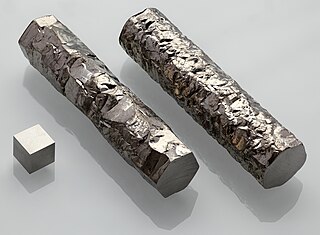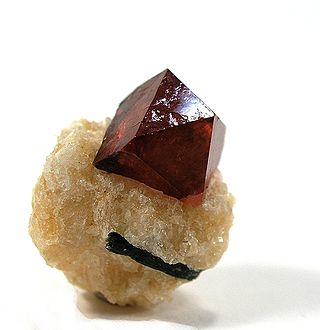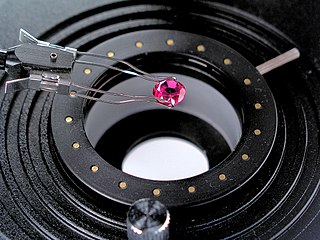Source
-
 This article incorporates text from a publication now in the public domain : Wood, James, ed. (1907). "Zirconia Light". The Nuttall Encyclopædia . London and New York: Frederick Warne.
This article incorporates text from a publication now in the public domain : Wood, James, ed. (1907). "Zirconia Light". The Nuttall Encyclopædia . London and New York: Frederick Warne.
A zirconia light is an intensely brilliant chemical light produced by incandescent zirconia. It is similar in design to the Drummond light (limelight), but uses a block of zirconia instead of quicklime. Both have been replaced by the electric light.

Zirconium is a chemical element with the symbol Zr and atomic number 40. The name zirconium is derived from the name of the mineral zircon, the most important source of zirconium. The word is related to Persian zargun. It is a lustrous, grey-white, strong transition metal that closely resembles hafnium and, to a lesser extent, titanium. Zirconium is mainly used as a refractory and opacifier, although small amounts are used as an alloying agent for its strong resistance to corrosion. Zirconium forms a variety of inorganic and organometallic compounds such as zirconium dioxide and zirconocene dichloride, respectively. Five isotopes occur naturally, four of which are stable. Zirconium compounds have no known biological role.

Zircon is a mineral belonging to the group of nesosilicates and is a source of the metal zirconium. Its chemical name is zirconium(IV) silicate, and its corresponding chemical formula is ZrSiO4. An empirical formula showing some of the range of substitution in zircon is (Zr1–y, REEy)(SiO4)1–x(OH)4x–y. Zircon precipitates from silicate melts and has relatively high concentrations of high field strength incompatible elements. For example, hafnium is almost always present in quantities ranging from 1 to 4%. The crystal structure of zircon is tetragonal crystal system. The natural color of zircon varies between colorless, yellow-golden, red, brown, blue, and green.

Cubic zirconia (abbreviated CZ) is the cubic crystalline form of zirconium dioxide (ZrO2). The synthesized material is hard and usually colorless, but may be made in a variety of different colors. It should not be confused with zircon, which is a zirconium silicate (ZrSiO4). It is sometimes erroneously called cubic zirconium.

Gemology or gemmology is the science dealing with natural and artificial gemstone materials. It is a geoscience and a branch of mineralogy. Some jewelers are academically trained gemologists and are qualified to identify and evaluate gems.

Zirconium dioxide is a white crystalline oxide of zirconium. Its most naturally occurring form, with a monoclinic crystalline structure, is the mineral baddeleyite. A dopant stabilized cubic structured zirconia, cubic zirconia, is synthesized in various colours for use as a gemstone and a diamond simulant.

Limelight is a type of stage lighting once used in theatres and music halls. An intense illumination is created when a flame fed by oxygen and hydrogen is directed at a cylinder of quicklime, which can be heated to 2,572 °C (4,662 °F) before melting. The light is produced by a combination of incandescence and candoluminescence. Although it has long since been replaced by electric lighting, the term has nonetheless survived, as someone in the public eye is still said to be "in the limelight". The actual lamps are called "limes", a term which has been transferred to electrical equivalents.
An oxygen sensor (or lambda sensor, where lambda refers to air–fuel equivalence ratio, usually denoted by λ) or probe or sond, is an electronic device that measures the proportion of oxygen (O2) in the gas or liquid being analysed.

In dentistry, a crown or a dental cap is a type of dental restoration that completely caps or encircles a tooth or dental implant. A crown may be needed when a large dental cavity threatens the health of a tooth. A crown is typically bonded to the tooth by dental cement. They can be made from various materials, which are usually fabricated using indirect methods. Crowns are used to improve the strength or appearance of teeth and to halt deterioration. While beneficial to dental health, the procedure and materials can be costly.

A diamond simulant, diamond imitation or imitation diamond is an object or material with gemological characteristics similar to those of a diamond. Simulants are distinct from synthetic diamonds, which are actual diamonds exhibiting the same material properties as natural diamonds. Enhanced diamonds are also excluded from this definition. A diamond simulant may be artificial, natural, or in some cases a combination thereof. While their material properties depart markedly from those of diamond, simulants have certain desired characteristics—such as dispersion and hardness—which lend themselves to imitation. Trained gemologists with appropriate equipment are able to distinguish natural and synthetic diamonds from all diamond simulants, primarily by visual inspection.

Yttrium oxide, also known as yttria, is Y2O3. It is an air-stable, white solid substance.

A ceramic knife is a knife with a ceramic blade typically made from zirconium dioxide (ZrO2; also known as zirconia), rather than the steel used for most knives. Ceramic knife blades are usually produced through the dry-pressing and firing of powdered zirconia using solid-state sintering. The blades typically score 8.5 on the Mohs scale of mineral hardness, compared to 4.5 for normal steel and 7.5 to 8 for hardened steel and 10 for diamond. The resultant blade has a hard edge that stays sharp for much longer than conventional steel blades. However, the blade is brittle, subject to chipping, and will break rather than flex if twisted. The ceramic blade is sharpened by grinding the edges with a diamond-dust-coated grinding wheel.

The Dead Moon Circus are a group of fictional characters from the Sailor Moon manga series created by Naoko Takeuchi. They serve as the main antagonists of the fourth arc, called Dream in the manga, Sailor Moon SuperS in its first anime adaptation, and Sailor Moon Eternal in the second anime adaptation. They are first introduced in chapter #39 "Dream 1 – Eclipse Dream", originally published in Japan on September 6, 1995. In the original English dubbed anime by Cloverway, they are called the "Dark Moon Circus".
Zirconium (IV) hydroxide, often called hydrous zirconia is an ill-defined material or family of materials variously described as ZrO2·nH2O and Zr(OH)4·nH2O. All are white solids with low solubility in water. These materials are widely employed in the preparation of solid acid catalysts.
Glass fibre reinforced concrete (GFRC) is a type of fibre-reinforced concrete. The product is also known as glassfibre reinforced concrete or GRC in British English. Glass fibre concretes are mainly used in exterior building façade panels and as architectural precast concrete. Somewhat similar materials are fibre cement siding and cement boards.
An air-fuel ratio meter monitors the air–fuel ratio of an internal combustion engine. Also called air–fuel ratio gauge, air–fuel meter, or air–fuel gauge, it reads the voltage output of an oxygen sensor, sometimes also called AFR sensor or lambda sensor.
Adhesive dentistry is a branch of dentistry which deals with adhesion or bonding to the natural substance of teeth, enamel and dentin. It studies the nature and strength of adhesion to dental hard tissues, properties of adhesive materials, causes and mechanisms of failure of the bonds, clinical techniques for bonding and newer applications for bonding such as bonding to the soft tissue. There is also direct composite bonding which uses tooth-colored direct dental composites to repair various tooth damages such as cracks or gaps.

Yttria-stabilized zirconia (YSZ) is a ceramic in which the cubic crystal structure of zirconium dioxide is made stable at room temperature by an addition of yttrium oxide. These oxides are commonly called "zirconia" (ZrO2) and "yttria" (Y2O3), hence the name.
Cubic Zirconia is an American electronic dance music trio from East Village, New York City composed of Tiombe Lockhart, Nick Hook and Daud Sturdivant. They have been noted for their energetic live performances and experimental sound, which combines elements from such genres as Chicago house music, neo-soul, rock and electro-funk.
Zirconia is an unincorporated community in Henderson County, North Carolina, United States. Zirconia is located on North Carolina Highway 225, 5.9 miles (9.5 km) south-southeast of Hendersonville. Zirconia has a post office with ZIP code 28790, which opened on June 9, 1853. The community was named for the valuable deposits of zircon in the area.

North Carolina Highway 225 (NC 225) is a 10.7-mile (17.2 km) route running from U.S. Route 25 (US 25), near the South Carolina state line to Hendersonville. It crosses over US 25 once before ending. It runs through East Flat Rock and near Lake Summit. The route is a prior alignment of US 25, designated after a new freeway was opened in stages from 1981–2003.